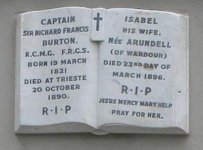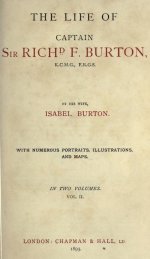Björn Bergenholtz
(former alias "Calalp")

Sigh! I thought the Thick-billed Seedeater a k a ditto Canary alt. Serin (in Swedish: burtonsiska) should be a quick one ...
• Thick-billed Seedeater (Serinus) Crithagra burtoni GRAY 1862 (here) as "Strobilophaga Burtoni", without any dedication nor explanation (not for that particular bird!), but the nextcoming one, following directly after, have an clear and out-spoken dedication;
• the invalid "Cosmetornis Burtoni"* GRAY 1862:
Well, all clues connected, case closed ... I thought ... until I noted that today's HBW Alive Key now gives us:
James, what made you change it? And why? Would Gray really have called it burtoni if he inteded it for Mrs. Burton? And would he have used the same name twice, on exactly the same page (both with masculine ending -i), with different intentions, without a remark?
Note that Gray, in the same paper, first page, first bird, on p. 443, also described "Cossypha Isabellæ" (there with feminine ening-æ), with the clear dedication: "This bird is named in compliment to Mrs. Isabel Burton." [i.e. today's Mountain Robin-Chat (Oreocossypha/ Sheppardia) Cossypha isabellae GRAY 1862 a k a Cameroon Mountain Robin (-Chat)].
None of the above mentioned birds to confuse with Spectacled Finch Callacanthis burtoni GOULD 1838 (here) as "Carduelis Burtoni" ... [which also gave us the invalid Generic name "Burtonia" BONAPARTE 1850 (syn. Callacanthis REICHENBACH 1850)]
Or have I got it all wrong regarding the Thick-billed one? And if so; where did I go astray?
Please enlighten me/us.
Björn
____________________________________________________
*not listed in the Key! A synonym for Pennant-winged Nightjar (Macrodipteryx/ Smeiophorus) Caprimulgus vexillarius GOULD 1838.
Regarding its synonymity see Cleere (2003), here, p.181-182.
• Thick-billed Seedeater (Serinus) Crithagra burtoni GRAY 1862 (here) as "Strobilophaga Burtoni", without any dedication nor explanation (not for that particular bird!), but the nextcoming one, following directly after, have an clear and out-spoken dedication;
• the invalid "Cosmetornis Burtoni"* GRAY 1862:
To me this looked like an "obvious one", all my notes and searches regarding this eponym pointed at the same guy ... also backed up by Jobling's Helm Dictionary of Scientific bird names (2010) where this eponym was explained as:The British Museum is indebted to the liberality of Capt. Burton, H.M. Vice-Consul, who has just sent it with other zoological specimens, all marked as from Fernando Po, and after whom I have the pleasure of naming this interesting bird.
And that´s what I believed, aimed at (the larger-than-life-charachter) Sir Richard Francis Burton (here), as he in the early 1860's served as British (vice) Consul on the Island Fernando Pó (today's Bioko, in Equatorial Guinea), and while there he spent much of this time exploring the coast of West Africa [the Type of (Serinus) Crithagra burtoni was collected in Cameroon Mountains, West Africa].burtoni [...] • Sir Richard Francis Burton (1821–1890), British explorer, scholar and linguist (Serinus)
Well, all clues connected, case closed ... I thought ... until I noted that today's HBW Alive Key now gives us:
His wife!? :eek!:burtoni
[...]
● Lady Isabel Burton née Arundell (1831-1896) wife of British explorer Capt. Sir Richard Francis Burton (Crithagra).
[...]
James, what made you change it? And why? Would Gray really have called it burtoni if he inteded it for Mrs. Burton? And would he have used the same name twice, on exactly the same page (both with masculine ending -i), with different intentions, without a remark?
Note that Gray, in the same paper, first page, first bird, on p. 443, also described "Cossypha Isabellæ" (there with feminine ening-æ), with the clear dedication: "This bird is named in compliment to Mrs. Isabel Burton." [i.e. today's Mountain Robin-Chat (Oreocossypha/ Sheppardia) Cossypha isabellae GRAY 1862 a k a Cameroon Mountain Robin (-Chat)].
None of the above mentioned birds to confuse with Spectacled Finch Callacanthis burtoni GOULD 1838 (here) as "Carduelis Burtoni" ... [which also gave us the invalid Generic name "Burtonia" BONAPARTE 1850 (syn. Callacanthis REICHENBACH 1850)]
Or have I got it all wrong regarding the Thick-billed one? And if so; where did I go astray?
Please enlighten me/us.
Björn
____________________________________________________
*not listed in the Key! A synonym for Pennant-winged Nightjar (Macrodipteryx/ Smeiophorus) Caprimulgus vexillarius GOULD 1838.
Regarding its synonymity see Cleere (2003), here, p.181-182.
Last edited:







